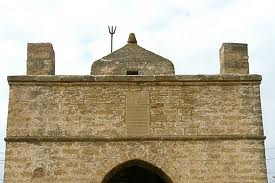
Thread.....The Greater Jwalaji Temple Baku, Azerbaijan. In 1883 Russian Czar Alexander Alexandrovich , known historically as Alexander III who reigned as Emperor of Russia, King of Poland and Grand Prince of Finland , went to Baku to visit the fire temple Ateshgah. 





He witnessed a full Vedic Agnihotra from the homan pit lit by a natural naphta fire , conducted by Indian Hindu Brahmins.
The fire temple at Baku was built during the reign of the great Indian Emperor Vikramaditya in 7000 BC, who ruled from Palestine to Urals to Vietnam.. In 1683 a German traveler Kaempfer has visited Baku. He noted that there are seven fire holes at the Hindu temple.
And there is an exact replica of this eternal natural gas flame temple on a smaller scale in India at Kangra valley Himachal Pradesh. This Indian temple is called Jwalamukhi, The Baku Temple is called the greater Jwalaji while the HP is called the smaller jwalaji
This Jwalaji temple in HP where Lord Shiva’s wife Sati’s tongue fell after she sacrificed herself in the yagna fire. The Baku temple is the place where her Heart fell. An inscription from the Baku Atashgah. The first line begins: I salute Lord Ganesha (श्री गणेशाय नमः) (see pic)
Near the temple is the Caspian sea. Caspian sea is originally Kashyapa sea. The caviar fish called “Kur Maachee” or Sevruga sturgeon caviar fish . Machee is fish in Sanskrit and Hindi. There are some persian as well as Gurumukhi inscriptions too
In the Lenin Museum in Moscow, the idols removed from baku temple are exhibited. The explanation in Russian says that Brahmins lived in Baku and had come from India and worked for money 

The location of this temple is Surakhani town in Baku which in Sanskrit means mine (Khani) of the Gods (Sur- opposite of Asur) where these Brahmins lived.
@mamatarsingh @Kautilya_tilak @LostTemple7 @Lost_History1 @DeepaShreeAB @VedicWisdom1 @VedicElement @Itishree001
@mamatarsingh @Kautilya_tilak @LostTemple7 @Lost_History1 @DeepaShreeAB @VedicWisdom1 @VedicElement @Itishree001
• • •
Missing some Tweet in this thread? You can try to
force a refresh





